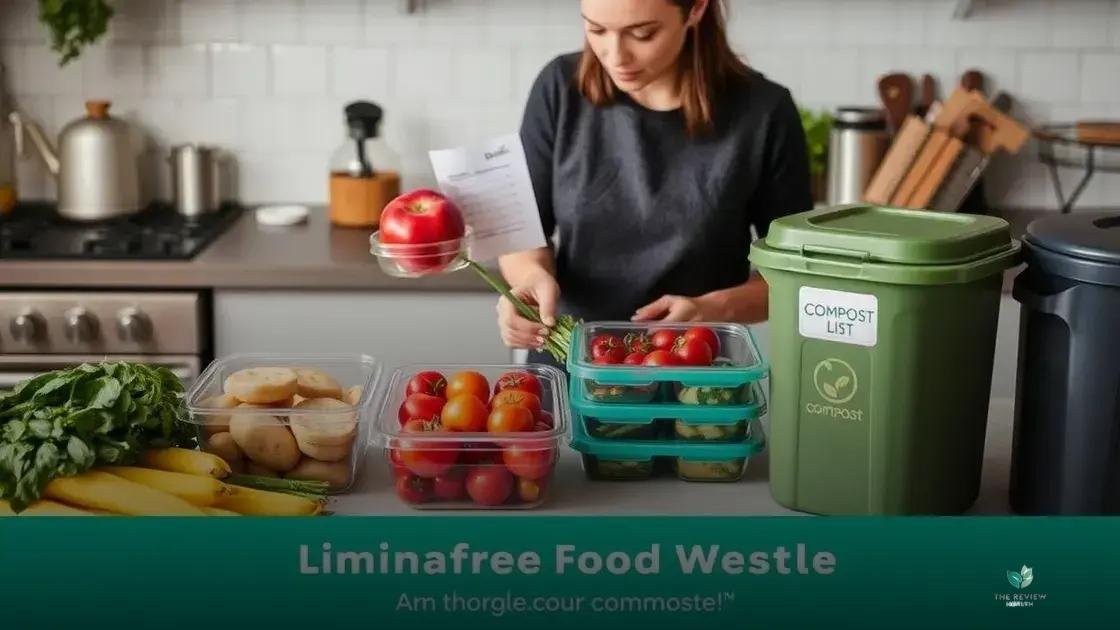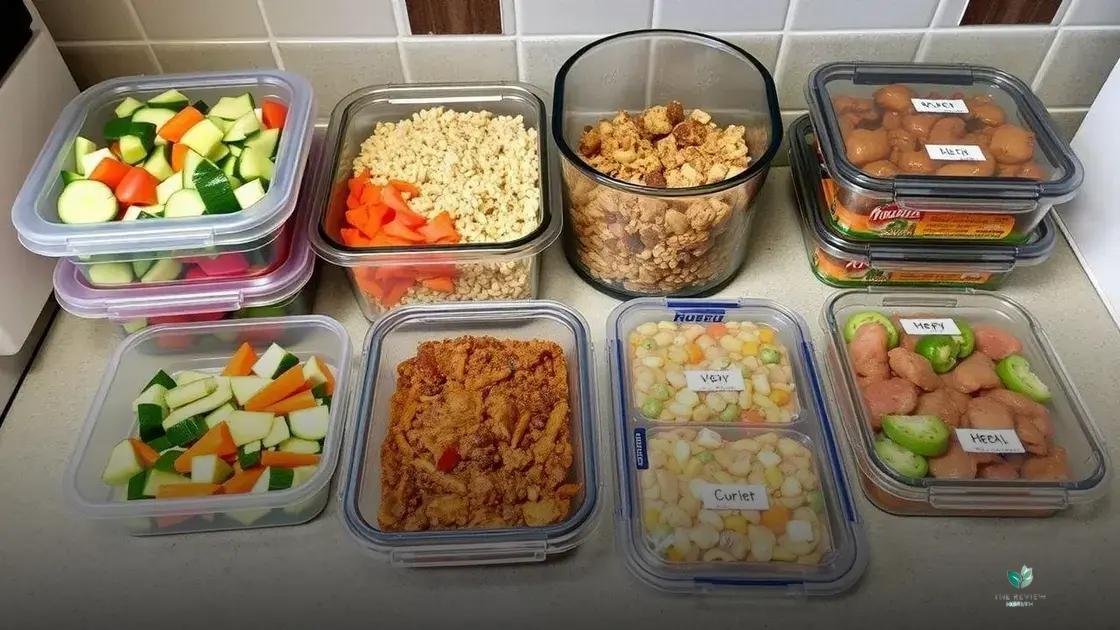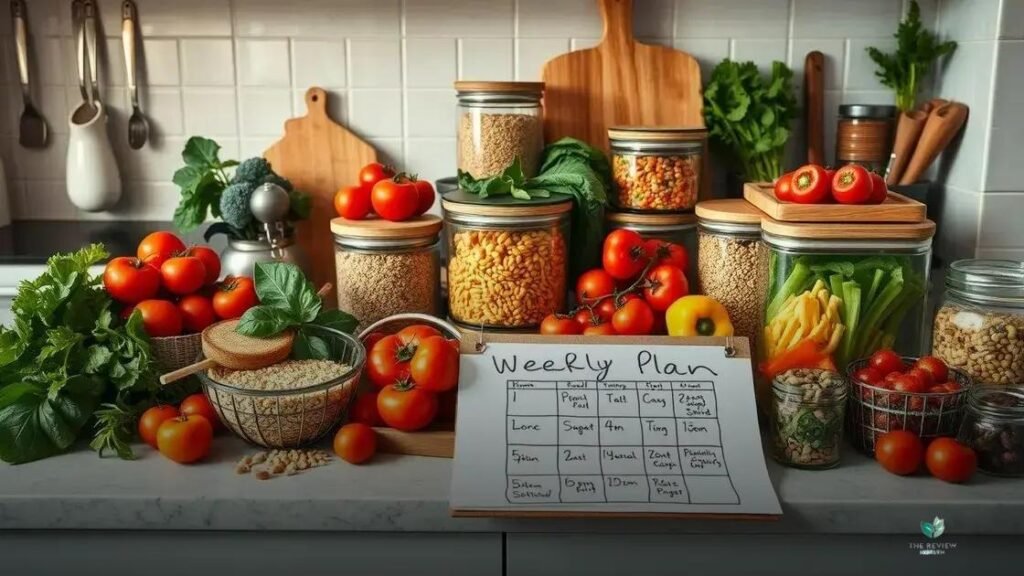Meal planning for zero waste involves strategically planning meals, shopping smartly with reusable containers, using all parts of ingredients, and storing food correctly to minimize waste and maximize freshness.
Getting started with meal planning can seem overwhelming, but it doesn’t have to be. Picture a week where cooking is stress-free, ingredients are fresh, and waste is minimal. Curious about how you can make this happen? Let’s dive into some simple strategies.
Understanding zero waste meal planning

Understanding zero-waste meal planning involves more than just using up leftovers. It’s a holistic approach to food management that minimizes waste at every stage, from shopping to storage and finally, consumption. This approach considers not only what we eat but also how we acquire, prepare, and ultimately dispose of our food.
Key Principles of Zero-Waste Meal Planning
Planning Ahead: A well-thought-out meal plan is the cornerstone of zero-waste cooking. By planning your meals for the week, you can create a precise shopping list, reducing impulse buys and ensuring you only purchase what you need. This minimizes the chances of food spoiling in your refrigerator.
Smart Shopping: Opting for fresh, seasonal produce and buying in bulk (when appropriate) can significantly reduce packaging waste. Consider visiting local farmers’ markets or joining a CSA (Community Supported Agriculture) for access to unpackaged, locally-grown foods. Remember to bring your reusable bags and containers!
Creative Cooking: Zero-waste cooking encourages resourcefulness in the kitchen. Embrace using all parts of vegetables, finding creative ways to incorporate leftovers into new meals, and saving food scraps for composting or stock-making. Think “root-to-stem” cooking.
Proper Storage: Utilizing appropriate storage containers and techniques can extend the life of your food, reducing spoilage. Invest in reusable containers and learn how to store different types of produce to maximize their freshness.
Practical steps for effective meal prep

Effective meal prep is the practical application of your zero-waste meal plan. It’s where you transform your plan into delicious, ready-to-eat meals, saving you time and reducing food waste throughout the week.
Batch Cooking and Ingredient Prepping
Batch cooking involves preparing large quantities of staples like grains, beans, or roasted vegetables that can be incorporated into various meals. This saves significant cooking time throughout the week. Ingredient prepping focuses on washing, chopping, and portioning ingredients. Having prepped ingredients readily available makes assembling meals quick and easy, encouraging you to stick to your meal plan.
Utilizing Leftovers Strategically
Don’t let leftovers go to waste! Plan to repurpose them creatively. Roasted chicken can become chicken salad or soup. Cooked vegetables can be added to frittatas or stir-fries. Get creative and think outside the box to minimize waste and maximize flavor.
Freezing for Future Meals
Freezing is your best friend for long-term meal prep and waste reduction. Freeze leftover portions, excess ingredients, or even complete meals for busy weeknights. Label and date everything clearly for easy identification and to ensure you use items before they expire. Consider using reusable freezer-safe containers to further reduce waste.
Example: If you’re roasting a whole chicken, plan to use the leftovers for chicken tacos later in the week, and freeze the carcass to make stock for soup another time.
The benefits of sustainable food storage

Sustainable food storage is a key element of zero-waste meal planning. It’s about maximizing the lifespan of your food while minimizing your environmental impact. Proper storage not only preserves freshness and flavor but also helps reduce food waste and saves you money.
Choosing the Right Containers
Invest in high-quality, reusable containers made from durable materials like glass or stainless steel. These are better for the environment than single-use plastic wrap or bags and can often keep food fresher for longer. Look for airtight seals to prevent spoilage and maintain optimal humidity levels for different types of produce.
Tips for Reducing Food Spoilage
FIFO Method: Employ the “First In, First Out” method. Organize your refrigerator and pantry so that older items are at the front and get used first, preventing food from getting lost and expiring in the back.
Proper Refrigeration: Store fruits and vegetables separately, as some fruits release gases that can cause vegetables to spoil faster. Learn the ideal storage conditions for different produce items – some belong in the fridge, while others are best stored at room temperature.
Freezing for Long-Term Storage: As mentioned earlier, freezing is a great way to preserve excess ingredients, prepped meals, or leftovers. Use airtight, freezer-safe containers and label everything clearly with the date to maintain organization and prevent freezer burn.
Making Meal Planning a Sustainable Habit
Zero-waste meal planning isn’t just about reducing waste; it’s about creating a healthier, more sustainable lifestyle. By embracing these strategies, you’ll find yourself saving time, money, and resources while enjoying delicious, home-cooked meals. Start small, experiment with different techniques, and find what works best for you. Every step you take towards reducing food waste is a step towards a more sustainable future.
FAQ: Your Questions About Zero-Waste Meal Planning Answered
What is zero-waste meal planning?
Zero-waste meal planning is a strategy for minimizing food waste by planning meals in advance, shopping strategically, using all edible parts of ingredients, and storing food properly.
How do I start meal planning for zero waste?
Begin by taking stock of your current food inventory, then plan your meals for the week, create a shopping list based on your plan, and prioritize using up leftovers creatively.
What are the benefits of zero-waste meal planning?
Benefits include reduced food waste, cost savings, healthier eating habits, less time spent grocery shopping, and a smaller environmental footprint.
What are some good food storage containers for zero waste?
Reusable glass or stainless steel containers with airtight seals are ideal for keeping food fresh and reducing the need for single-use plastics.
What can I do with leftover food scraps?
Compost vegetable scraps, fruit peels, and coffee grounds. Save bones and vegetable scraps to make homemade stock. Use stale bread to make croutons or breadcrumbs.
How can I make zero-waste meal planning fit my busy schedule?
Start with small steps. Plan just a few meals a week initially, and gradually increase as you become more comfortable with the process. Batch cooking and ingredient prepping can save significant time.

Sarah Thompson is a passionate advocate for healthy living and mindful lifestyle choices. With a background in nutrition science and years of experience as a wellness coach, Sarah dedicates her time to exploring the latest trends, research, and products that promote physical, mental, and emotional well-being.
As the lead writer for The Review Health , Sarah combines her expertise with a genuine love for helping others make informed decisions about their health. Her articles are designed to inspire and educate, offering practical tips, honest reviews, and science-backed insights to support readers on their journey to a healthier, happier life.
When she’s not writing or researching, Sarah enjoys yoga, experimenting with plant-based recipes, and spending time outdoors with her family.



